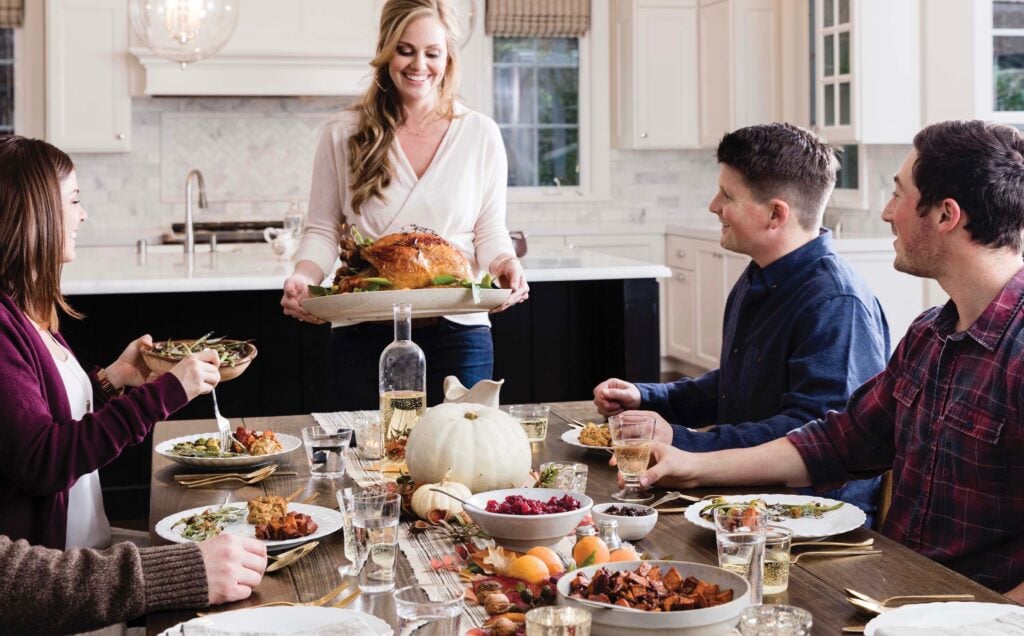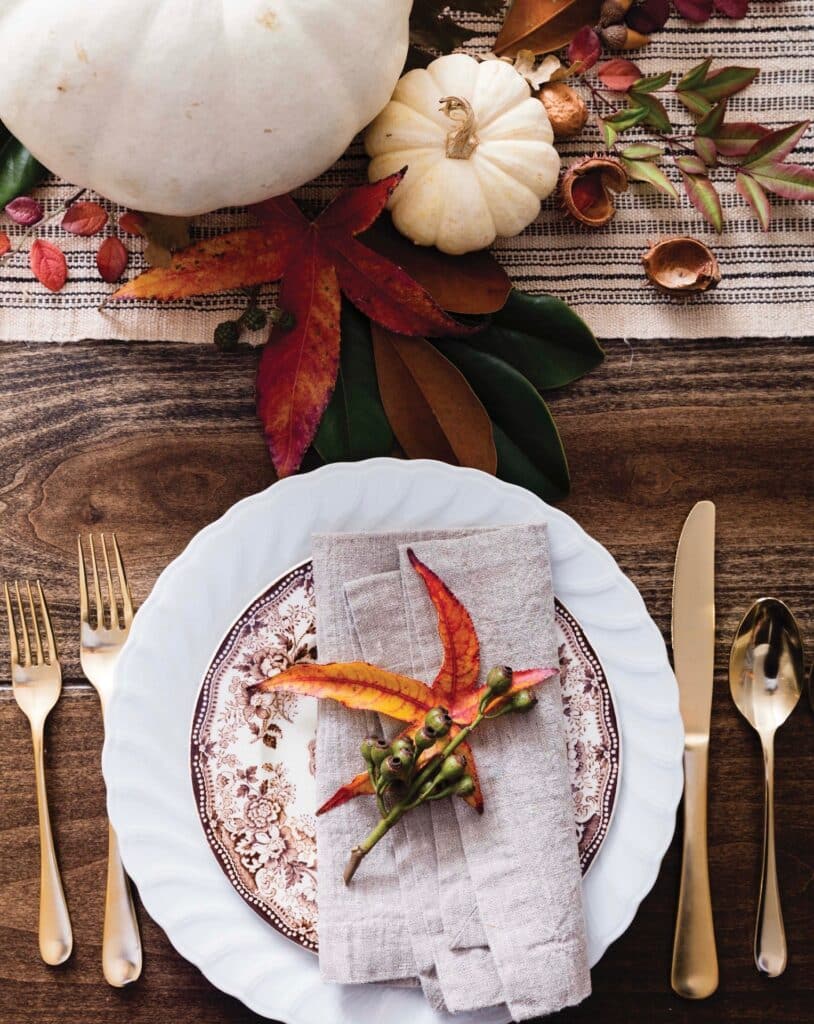Thanksgiving Turkey with ButcherBox
Danielle Walker - AgainstAllGrain.com
10 - 12
American
Dinner
25 hours mins
2- 3 hours mins
27 mins
Ingredients:

brine
- 8 quarts water
- 11⁄4 cups coarse sea salt
- 4 bay leaves
- 1 (750ml) bottle Pinot Grigio (or other dry white wine)
- 1⁄4 cup light-colored raw honey or coconut sugar
- 8 cloves garlic, crushed
- 2 yellow onions, quartered
- 1 bunch fresh thyme
- 1 tablespoon allspice berries
- 1 tablespoon juniper berries
- 1 tablespoon peppercorns
- 2 teaspoons anise seeds
- 1 fresh or frozen and defrosted whole turkey, neck and giblets removed and saved for stock
- 3 yellow onions, quartered
- 2 carrots, peeled and quartered 4 ribs celery, quartered
- 8 cloves garlic, 4 peeled and crushed and 4 whole with peels
- 1 whole lemon, halved
- 2 sprigs rosemary
- 1 bunch flat-leaf parsley
- 1 bunch thyme
- 1⁄4 cup melted ghee (page 325)
- 1⁄4 cup extra-virgin olive oil
pan gravy
- Reserved onions, garlic, and celery from roasting pan
- Pan drippings
- 11⁄2 cups turkey or chicken stock, plus more as needed
- Sea salt and freshly ground black pepper
Instructions:
Helpful tips before you begin:
A brine is a mixture of salt, liquid, and spices and is used to seal the outer pores of the turkey, trapping in all of the juices and tenderizing the meat. If your turkey is frozen, be sure to defrost it fully in the fridge before brining. You’ll need to allow about 24 hours for each 5 pounds of frozen turkey you plan to thaw.
I think it is always best to go with a simple turkey preparation, especially after brining it. The mix of ghee and olive oil helps to create that crispy skin we all love, but you can also use duck or bacon fat if you want to stay away from dairy. I start the roasting at a high temperature to brown the skin and speed up the process, then finish it at a lower temperature to ensure a moist turkey every time.
Turkey and mashed cauliflower are not the same to me without creamy seasoned gravy, but the way my dad and grandmother always made gravy was with cornstarch or wheat flour and artificial flavoring like Kitchen Bouquet. Here, I use the flavorful pan drippings with chicken stock and puree it with the roasted vegetables from the turkey pan to thicken it.
The Brine:
- To make the brine, heat 1 quart of the water in a large stockpot over medium-high heat. Stir in the salt, bay leaves, wine, honey, garlic, onions, thyme, allspice, juniper, peppercorns, and anise seeds and continue stirring until the salt dissolves. Remove from the heat and pour in the remaining 7 quarts water. Let cool to room temperature. Pat the turkey dry and place it in a brining bag or a pot large enough to hold the turkey submerged in the brine. Pour the brine over the bird so it is submerged and seal the bag or cover the pot. Place in the refrigerator for 24 hours. T
The Turkey
- Rinse the bird and pat dry, inside and out, with paper towels. Arrange it breast side up on a roasting rack set inside a roasting pan and allow it to stand at room temperature for 1 hour before roasting.
- Remove all but one of the oven racks in the oven and position that rack in the bottom third of the oven. Preheat the oven to 500°F.
- Place 1 onion, all of the carrots, half of the celery, and the peeled garlic cloves inside the cavity of the bird. Squeeze the juice of the lemon into the cavity and stuff the lemon halves inside with the rosemary, parsley, and thyme. Tie the drumsticks together with kitchen twine.
- Combine the melted ghee and olive oil in a bowl and rub some of it all over the skin. Reserve the remainder for basting. Scatter the remaining 2 onions, 2 celery ribs, and whole garlic cloves on the bottom of the pan.
- Roast the turkey for 30 minutes. Rotate the pan 180 degrees, baste the turkey with the remaining oil mixture, then reduce the oven temperature to 350°F. Continue roasting until a thermometer reads 165°F when inserted into the thickest part of the thigh or the juices run clear when the thigh is pierced. A 12- to 14-pound bird will take 11⁄2 to 2 hours longer (a 14- to 16-pound bird will take 2 to 21⁄2 hours longer).
- Let the turkey rest, loosely covered with aluminum foil, for 15 minutes before carving.
The Gravy:
- For the pan gravy, transfer the reserved onions and celery from the bottom of the roasting pan to a blender.
- Pour the drippings from the pan into a fat separator and pour off the fat. Pour the drippings into the blender. Alternatively, tilt the pan and skim off as much fat as possible, then pour the drippings into the blender. Squeeze the roasted garlic out of the peels and add to the blender. Add the stock and puree on high until smooth and thick. Add additional stock until it reaches a desired thickness. If the gravy is too thin, add a few pieces of onion from the cavity of the bird to thicken. Season with salt and pepper to taste. Note that the brine causes the gravy to be salty already, so you may not need to add any at all.
tidbits: Don’t have a pot large enough for brining the turkey? Try a cooler or a clean bucket that is big enough for the bird but small enough to fit in the fridge. Remove the shelves from the fridge, if necessary.
Do not bake your stuffing inside the cavity of a brined turkey and do not salt your gravy. There’s enough salt already from the brine.
Roasting times may vary depending on the type of turkey you purchase. These times relate to an organic, pasture-raised bird, which tends to be slightly leaner than a conventional turkey.
Reheat leftover turkey in a covered dish with a small amount of turkey or chicken stock at the bottom to help keep it moist. Use other leftovers in the recipes that follow, or make a pot pie using extra pan gravy (page 254) and my pie pastry (page 323).
Know your bird: While turkeys are in abundance at supermarkets during the holiday months, a good-quality turkey may need to be ordered in advance. Check with your local butcher, Whole Foods, or favorite vendor at your farmers’ market toward the end of October to ensure you get it by the big day. I allot
11⁄2 pounds of turkey per person when deciding how large of a bird to buy. This will give you enough for dinner and some leftover for soups and sandwiches the next day. If possible, buy a 100 percent pasture-raised turkey, as it will be superior. The label ensures that the bird was allowed to roam freely and forage on the ground, as it was meant to. It also means the bird was not given a feed of soy, corn, or other grains. Heritage and organic birds are also a great option.
Did you enjoy this recipe? If you make this and love it, please post a photo on social media and use #daniellewalker and @daniellewalker so I can see it!
paleo, gluten free, butcherbox, danielle walker, against all grain, cookbook, Celebrations cookbook, Thanksgiving, November, Holidays
Hi there! The photos of this recipe and content above are copyright protected.
Please do not use our photos without prior written permission. Please do not copy this recipe and share it on your own site. If you wish to tell people about this recipe, please provide a link back to the recipe here on my blog rather than copying the recipe. If you make significant changes to a recipe, you are welcome to rewrite it in your own unique words and provide a link back here for credit. Thank you!







Christine
Hi Danielle! So I made your Turkey recipe last year and it turned out GREAT!! But I can’t remember what I did. I am using a roaster but it only goes up to 450. Your recipe has it cooking at 500 for 30 minutes. Is it best to do that in the oven for that part and then transfer to the roaster?! Agh…I can’t
Remember what I did. Any tips would be appreciated!! Thank you!! Christine
Danielle
Hi! Yes – that would work! I hope it turns out great – enjoy!!